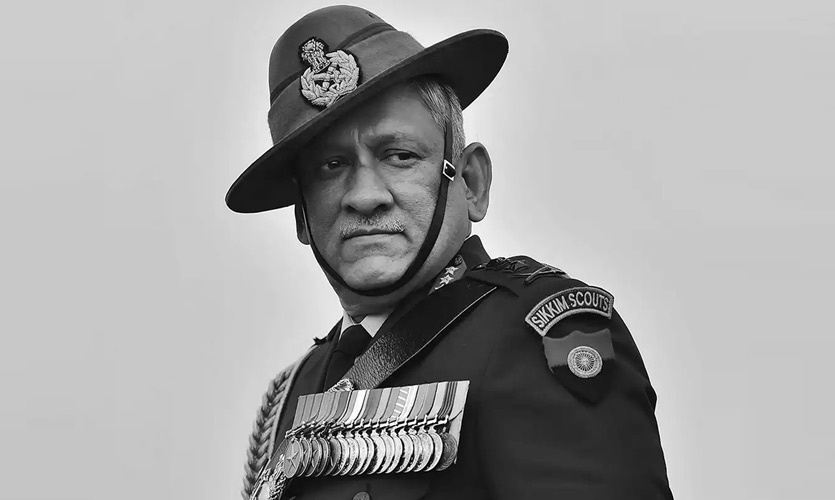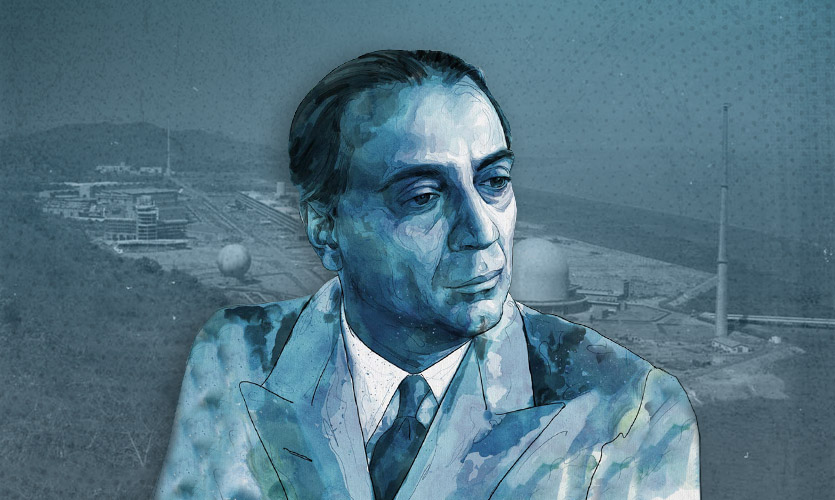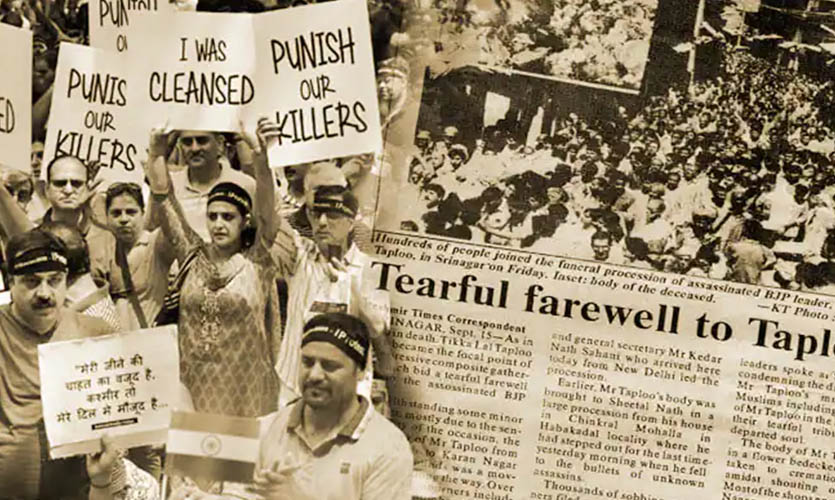India has suffered a tragic loss with the death of CDS General Bipin Rawat, whose boots will be hard to fill.
India’s first Chief of Defence Staff General Rawat died on December 8 during a fateful chopper ride from the Sulur Airforce base to the Defence Staff College in Wellington, Tamil Nadu. He was accompanied by his wife Madhulika Rawat and 12 other defence personnel: Defence Adviser Brig Lakhbinder Singh Lidder, Staff Officer Lt Col Harjinder Singh, Group Captain Varun Singh, Wing Commander Prithvi Singh Chauhan, Squadron Leader Kuldeep Singh, Junior Warrant Officer Rana Pratap Das, Junior Warrant Officer Arakkal Pradeep, Havildar Satpal Rai, Naik Gursewak Singh, Naik Jitendra Kumar, Lance Naik Vivek Kumar, Lance Naik B Sai Teja. Group Captain Varun Singh is the lone survivor, currently on life support.
The country has been in a state of mourning since news of the top officer’s accident broke yesterday afternoon. Known to call it like he sees it, General Rawat is one of the key personalities responsible for driving India’s defence system towards becoming self-reliant.
Legacy
On December 30, 2019, General Bipin Rawat was named India’s first Chief of Defence Staff, the highest-ranking military officer, appointed with the agenda of integrating the Indian Air Force, Army and Navy. The Indian government raised the age bar from 62 to 65 years, to make way for the appointment of the outgoing Chief of Army staff.
First inducted in the 5th battalion of the 11 Gorkha Rifles, on December 16, 1978, Rawat went on to command the battalion as a colonel at Kibithu, Arunachal Pradesh, along the Line of Actual Control. Specialising in counterinsurgency and high-altitude operations, he commanded 5 Sector of Rashtriya Rifles at Sopore, Jammu and Kashmir as a brigadier. Rawat was also in charge of the 21 Para Special Forces as Dimapur-based 3 Corps Commander Lt General in 2015, when the unit carried out cross-border strikes at a National Socialist Council of Nagaland (NSCN-K) base in Myanmar, to avenge the deaths of 18 Indian Army soldiers attacked by the militants in June that year. He was also at the centre of the counterinsurgency cross-border strikes into Pakistan-occupied Kashmir along the Line of Control in September 2016 following the Uri incident, “the deadliest attack on security forces in Kashmir in two decades” that killed 19 Indian Army soldiers. General Rawat has played a defining role in reducing the gap between low-ranking Indian Army officers and its top brass and resolving inter-departmental conflicts such as the government-military pay commission. He is known for protecting his soldiers, like in the case of Major Leethul Gogoi when he faced outrage for tying a stone-pelter to a military vehicle as a human shield in Kashmir, in order to ferry stranded poll workers to a safer location.
During his presidency of the Gorkha Brigade, General Rawat presided over 43 Gorkha Army battalions, the size of which is more than the entire British infantry. The de facto head of the Integrated Defence Staff of India, General Rawat was also head of the Department of Military Affairs and the Defence Policy Group, making him one of the few army veterans in complete sync with the government and a reliable asset. A Sword of Honour awardee from the Indian Military Academy, he also led the UN mission to the Democratic Republic of the Congo and was tasked with providing tactical support to the struggling Congolese Army. Rawat, then a brigadier, not only ensured the success of the mission but also built camaraderie with the vulnerable local population that finally assisted them in crushing the rebels.
General Rawat has also been instrumental in catering to India’s defence needs by shifting the focus towards incorporating theatre commands and becoming self-sufficient in terms of defence production. His behemoth task of the theaterisation of the Indian Armed Forces involved creating four integrated theatre commands – two land, one air defence, and one maritime – out of the existing 17 single-service commands, to be best prepared for future inevitable security threats. Given evolving geopolitics of the region, he anticipated the need to be atma nirbhar and therefore, encouraged the indigenous production and innovation of modern weapon systems and defence equipment. This is also to help fix India’s “Achilles heel” in terms of defence acquisition, since more than 50 percent of its defence needs are covered by imports. He also boosted private sector participation in defence production by urging transfer of technology.
Speculation & Questions Around Death
After Defence Minister Rajnath Singh apprised the Parliament of the chronology of events leading to the chopper crash, the Leader of Opposition Mallikarjun Kharge requested that he and other leaders should be allowed to speak on the tragic incident on the floor. However, Deputy Chairman Harivansh N. Singh disallowed it. While it is easy to get lost in the sorry state of the politics of our country, probing the cause of the crash is of utmost importance.
While a tri-service inquiry has been ordered and the black box recovered at the highest priority, this incident raises serious questions. General Rawat was the highest-ranking military officer of India. A chopper carrying high-ranking military officers is always checked thoroughly before it takes flight. A chopper carrying the CDS would be double-checked thoroughly. Does that really leave space for a technical difficulty not known beforehand? Given the climactic conditions, the slightest hint of a machinery failure would not have been left unattended as per the standard protocol. It is one of the worst accidents in military history, after the 1963 crash in the Poonch district of Kashmir that led to a revision of security protocol, barring two senior officers of the same or different forces from travelling in the same chopper.
The incident has also raised questions on the inadequacy of Mi-17 helicopters. The Russian-made helicopters are reportedly fitted with a Digital Flight Data Recorder and Cockpit Voice Recorder adjacent to each other in the tail boom. The data comprising analogue and other discrete parameters is sent to Moscow to be decoded. A similar incident was recorded in 2011 when a Pawan Hans Mi-172 helicopter with 35 people on board caught fire after descending below the level of the Tawang Civil Helipad and toppling over, resulting in 19 fatalities. “The accident was survivable. However, people died mainly due to inadequate fire services and non-availability of crash equipment and trained personnel,” said the investigation in-charge, Air Marshal (Retd.) P.P. Rajkumar. He had also stated in his report that the crew had disregarded the local temperature and pressure settings, which had contributed to the accident. While tragic, this negligence seems uncharacteristic of a flight carrying the CDS. Moreover, the Mi17V5 chopper General Rawat was on is the most technically advanced of the Mi-8/17 family. Equipped with TV3-117VM engines, it has a PKV-8 autopilot system and the most upgraded night vision devices. A Newslaundry article has hinted at the possibility of sabotage: “all it would take is to loosen a few nuts and bolts”.
Reportedly, the chopper “took a very unusual aerial route”. Havildar R.S. Kumar, an ex-serviceman from Coonoor who served at the Madras Regimental Centre in Wellington, Siachen and Ladakh, told the Deccan Chronicle: “The army and IAF staff on duty at the helipad usually have to give a green signal for landing. But, on Wednesday, the IAF chopper, instead of flying above Pakkasauranmalai, took a very unusual aerial route in the valley right above Ooty-Coimbatore NH in the Katteri-Burliar sector sandwiched between Pakkasuranmalai and the wooded Nanjappachathiram slopes. The valley was engulfed in mist. It is puzzling why the pilot took this route and who gave the clearance. No one knows whether the chopper developed any technical snag mid-air.”
The Cabinet Committee on Security met yesterday post haste, headed by Prime Minister Narendra Modi and with Home Minister Amit Shah, Defence Minister Rajnath Singh, Finance Minister Nirmala Sitharaman, and NSA Ajit Doval in attendance. Keeping the security threats India continues to face from her neighbours to the north and the west, appointing a new CDS is one of the most important tasks this government currently faces. That said, India will always remember this black letter day, and the brave heroes she lost untimely.
The Horus Eye is a weekly column written by Divya Bhan analysing current affairs and policies. This column does not intend or aim to promote any ideology and does not reflect the official position of The Sparrow.
Also read: Are The Recent Killings In Kashmir Dying Embers Of Prolonged Terror?
Also read: Has Communal Violence In Bangladesh Justified The Need For CAA?










